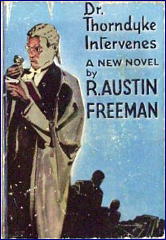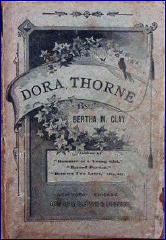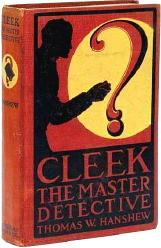Sat 23 May 2009
David L. Vineyard on PHILIP MacDONALD, DR. THORNDYKE, THOMAS HANSHEW and BERTHA CLAY.
Posted by Steve under Authors , Characters[9] Comments
I know a lot of classical detective fans don’t care for MacDonald because he tends toward suspense and even melodrama, but I’ve always thought his best books a sort of antidote to the driest and most formal of the golden age.

I love a good puzzler, but some of the practitioners sometimes forgot that one of the essential parts of the definition of mystery involves some sort of emotional response, not merely intellectual stimulation. Only Freeman ever managed to be dull and interesting, and Dr. Thorndyke is a hard act to follow and most got the dull part right, but not the interesting part.
Thorndyke is unique among fictional detectives in that he came first, and then the real life model, Sir Bernard Spilsbury. Most people don’t realise how much impact Thorndyke had on actual forensic investigation. I don’t know if it still is that way, but the box the forensic kit used to be carried in was always green after Thorndyke’s green forensics kit.
Much of the actual procedure of evidence collection used by the Yard and then by police around the world was taken from Freeman’s descriptions, and the actual forensics box based on his.
I ran across a terrific article in a 1914 issue of the New York Times on their archive site. Seems when Thomas Hanshew, author of the “Cleek, Man of Forty Faces” books (John Dickson Carr was a huge fan), was suspected to have been Bertha M. Clay when he died.
Hanshew, an actor who was one of Ellen Terry’s stock company, and died in England where he was living (and where the Cleek books are set), was a hugely prolific writer who wrote some 150 novels.

Clay, who was Charlotte M. Brame, was a popular writer of books for women (notably young women) whose work was issued in paperbound editions similar to the Nick Carter Nickel Library.
When she died in 1884 Street and Smith were unwilling to give up the golden goose, and apparently Hanshew, John Corryell (Nick Carter), and others took over, sometime writing from her notes, other times probably writing their own books.
The article is particularly kind to both Hanshew and Clay, and not the least snobbish (well, a little when it refers to her young female readers with mint on their breath — waiting in vain, we assume, for that first kiss), and even gives a few examples of how Hanshew changed Clay’s originals to his own style.
The article comes complete with a very nice drawing of Hanshew, who was a handsome fellow. If you have never read the Hanshew books, many of them can be downloaded from Google Books On-Line library, and while they are full of melodrama and over the top writing, you will begin to see what Carr liked about them. I freely admit I sometimes get my fill of the literary and want something bad but fun. Hanshew made the cut in Bill Pronzini’s Gun in Cheek books, and deserves it. He is a true alternative classic.

Hanshew doesn’t play fair as a detective novelist, but Cleek is an interesting character. The heir of a royal throne, he is the finest cracksman in London (The Vanishing Cracksman), but as usual true love turns his hand and he reforms, being hired by Maverick Narkom (great name) Superintendent of Scotland Yard as a consulting detective.
High handed and theatrical (as you might expect from an actor) the books are bad writing at its best. One of the stories seems to me may have been the source for one of Dorothy Sayers Wimsey shorts, the one where Lord Peter finds the sculptor is hiding real bodies in his bronzes.
Impossible crimes and locked rooms are common stuff, but the solutions are often of the poison unknown to science type. The Google edition available of Cleek of Scotland Yard includes the photos from either a silent film or play (I’m not sure which).
Little as either Clay or Hanshew is known now, it seem strange that they should have merited a New York Times article in 1914. Anyway, sometime you might treat yourself to a taste of Cleek, his true love Alicia, his servant Dollops, Mr. Maverick Narkom, and Margot, Queen of the Apaches (French Apaches, not American ones). Readers once read this breathlessly, and truth be told even today they can take your breath away, though not perhaps as they intended to.
May 24th, 2009 at 7:51 pm
Some of Hanshew’s tales have good mystery plots.
My comments on Hanshew are at:
http://mikegrost.com/hanshews.htm#Hanshews
May 24th, 2009 at 10:18 pm
Mike is right. Hanshew falls into the category of good or great bad writers. Cleek is interesting, and there is much in the books that is worthwhile. Most of the melodrama is good melodrama, as you might expect from an actor. I would even rate Hanshew above some of the Arthur B. Reeve Craig Kennedy books, certainly above the novelizations of serials like Exploits of Elaine and Man of Mystery (though those can be fun in the right mindset).
Mike mentions in his reviews whether Freeman influenced Hanshew, and it is possible, although it is more likely coincidence, however I think the influence of Hanshew on Christie that he suggests is likely. The Cleek stories were popular and she could well have read them. Certainly one of the stories is awfully close to the Lord Peter tale I mention by Sayers. Both Hanshew and Reeve were favorites of the young John Dickson Carr who never minded a bit of melodrama. As Mike says some of the detection is fairly good.
Hanshew isn’t without talent, but he was writing for an audience a bit below the level of Freeman or Conan Doyle. He reminds me a bit of the Aurelius (Secret Service) Smith tales of R.T.M. Scott, who like Hanshew labored in the early pulps and popular fiction mills (Scott of course created The Spider and wrote the first book in the series).
I don’t know that I would reccommend the Hanshew or Kennedy tales the same way I would Freeman, Post, or Morrison, or some of the other contemporaries of Conan Doyle, or even put them at quite the level of Boothby, Pemberton, Shiel, or Hesketh Pearson, but they are a step above the level of Nick Carter and certainly, depending on your tolerance for melodrama and histronics, worth discovering. But then I cheerfully admit enjoying the Nickel Library exploits of Nick Carter and his Brit. cousin Sexton Blake from the period. If you can tolerate the likes of G.A. Henty, George Barr McCutcheon, and William Murray Graydon you probably won’t have any trouble with Hanshew. It all depends on your tolerance for a simpler stye of writing and the tropes of popular fiction of another age. You can get quite involved in some of the better Cleek tales. Just be forewarned.
May 25th, 2009 at 4:00 pm
[…] which is exactly what the title says. I was prompted in doing so because of David Vineyard’s recent post which also mentioned both Freeman and […]
July 9th, 2009 at 3:10 pm
I agree with Mike Grost that Thomas Hanshew must have had an influence on Agatha Christie. I’ve just read Hanshew’s “The Riddle of the Rainbow Pearl” and its plot reminds me of Christie’s “The Adventure of the Christmas Pudding” (which features Poirot). In both stories the plot revolves around a dissipated prince who loses his country’s famous crown jewel to an unscrupulous woman with whom he’s having an affair. In order to avoid a revolution the jewel must be returned to the monarchy before the prince’s upcoming wedding.
I also see Conan Doyle’s influence on Thomas Hanshew. The plot of Hanshew’s “The Mystery of the Steel Room is very similar to Doyle’s “Adventure of the Speckled Band.”
I’ve just started reading some of the “forgotten” early mystery writers (like Hanshew), and it’s interesting to compare their stories to the famed Golden Age authors.
July 9th, 2009 at 5:03 pm
This is a very interesting comment!
I missed the connection between Hanshew and Christie’s “The Adventure of the Christmas Pudding”. Thanks to Diane Hadac for pointing it out!
This makes a good addition to the links between Hanshew and Christie mentioned on my web site.
Wonder if there are more connections!
July 10th, 2009 at 9:14 pm
Thanks, Mike! As I mentioned, this is my first foray into reading Hanshew and I was struck by the similarity between his story and Christie’s. I recently discovered Hanshew and several other early practitioners of the genre in Vol. VII of THE WORLD’S BEST 100 DETECTIVE STORIES, edited by Eugene Thwing and published by Funk & Wagnalls in 1929, which I found in an antique store. (There are ten volumes to the set; but unfortunately, the store only had Vol. VII, or I’d have bought them all.)
In addition to “The Riddle of the Rainbow Pearl,” Vol. VII has Hanshew’s “The Mystery of the Steel Room” (a “locked room” tale)and “The Divided House,” (a contrived death by “mysterious illness”) both of which I thought were excellent examples of their particular sub-genres.
I intend to read more of Hanshew’s work, and if I notice any other connections between his stories and Christie’s, I’ll be sure to pass them along.
July 13th, 2009 at 8:34 pm
Diane,
I first read these Hanshew tales in the same anthology!
Two years ago, a local used book had three (out of the ten) volumes of THE WORLD’S BEST 100 DETECTIVE STORIES. The stories are just terrific. Lots of rarities never seen elsewhere. Like you, I wish I had all ten volumes.
Then I ordered a used copy of the whole Hanshew book.
July 21st, 2009 at 3:31 pm
Hi Mike,
Small world, isn’t it? I’m still searching for the other nine volumes of THE WORLD’S BEST 100 DETECTIVE STORIES, too! Great stories by mostly forgotten masters of the mystery genre. Some enterprising publisher should reprint the series for those of us who enjoy stories that make you think. Did you get the Hanshew book on line?
September 9th, 2009 at 3:20 pm
[…] relation to Hanshew and Cleek I’ve previously mentioned [Comment #2] a story that I thought might have inspired one of Dorothy L. Sayers more bizarre and […]